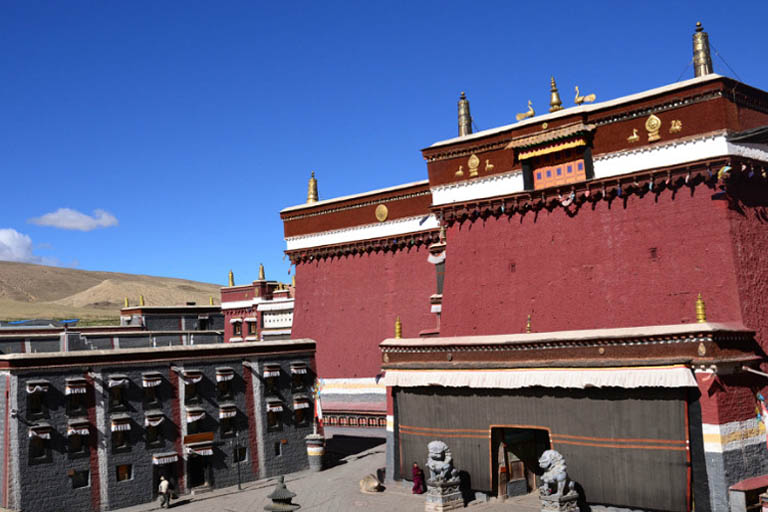1. Mount Everest - The Highest Mountain in the World
Altitude: 8,848 meters
Best Time to Visit: Summer & Autumn
Mt. Everest, the top of the World, is the must-go destination of your life journey. As the goal achievement
of many mountaineers, it shows the most beautiful natural beauty in the world, including perennial snow,
amazing sunrise and sunset, dazzling starry sky etc. learn more >
2. Sakya Monastery - The Oldest Temple of Sakya Sect of Tibetan Buddhism
Altitude: 3,000 meters
Best Time to Visit: Summer & Autumn
Sakya Monastery is the principal monastery of the Sakyapa Sect of Tibetan Buddhism, located in Sakya County,
about 160km southwest of Shigatse, on the road to Tingri in Tibet. Built in 1073 by Khon Khonchong Gyalpo, on
the hill side with gray earth surrounded, it means the “Grey Soil” in Tibetan. learn more >
3. Tashilhunpo Monastery - Seat of Panchen Lamas
Altitude: 3,880 meters
Best time to visit: Summer & Autumn
Tashilhunpo Monastery is the seat of successive Panchen Lamas. Founded by the First Dalai Lama, it is an
important monastery in Tibetan history. It keeps many treasures, including the priceless Future Buddha Statue,
precious Buddha Stupas, and more manuscript Buddhist texts and numerous murals. learn more >
4. Palcho Monastery - Ancient Monastery with Kumbum Stupa
Altitude: 3,900 meters
Best time to visit: Summer & Autumn
Palcho Monastery is a typical combined building with stupa and temple, and quite different from other Tibetan
monasteries in more aspects. By housing three sects of Sakyapa, Kadampa and Gelugpa together, it has a
hard-won lenient tolerance among the Tibetan sects to balance them well. learn more >
5. Gyantse Dzong - Historical Patriotic Ruins
Altitude: 4,140 meters
Best time to visit: April to October
Perched high above the center of Gyantse Ancient Town, Gyantse Dzong (Gyantse Fortress) is one well preserved
Dzong with historical significance in Tibet. Climbing to the top of Gyantse Dzong, you will get the fabulous
view of Palcho Monastery and Gyantse’s whitewashed old town below. learn more >
6. Karola Glacier - Giant Ice Wonder by Road
Altitude:: 5,560 meters
Best time to visit: Summer & Autumn
Within only 300 meters from the highway which connects Lhasa and Gyantse, Karola Glacier can be seen easily
when your car pass by. It is made of an ice cap with slow slope and two hanging-glacier typed glacier tongues,
occupying 9.4 square kilometers and reaching to 5,560 meters high. learn
more >
7. Yamdro Lake - Sapphire Decoration on Holy Land
Altitude: 4,441 meters
Best time to visit: Summer & Autumn
Among the three holy lakes in Lhasa, Yamdrok Lake is the most reachable one. Without an outlet, it seems like
a natural reservoir with a perfect balance between the melted snow water and the evaporated lake water. By
standing the hilltop around, you can have a far view of the fresh water under the sunshine. learn more >
8. Potala Palace - Spritual Heart of Tibet
Altitude: 3,700 meters
Best time to visit: April to October
Only the given words cannot form the real Potala Palace. It's not only the center of Lhasa, the house of
treasure, or the winter palace of Dalai Lama, but also the start of your Tibet Travel, an essential part of
your life journey. learn more >
9. Jokhang Temple - Most Sacred Center of Lhasa City
Altitude: 3,650 meters
Best time to visit: April to October
The 1,300-year-old Jokhang Temple is the spiritual center of Lhasa permeated with intense incense. The
life-sized statue of the Shakyamuni at the age of 12 is worshiped in the main hall. learn more >
10. Sera Monastery - Featured Tibetan Buddhism Debating
Altitude: 3,700 meters
Best Time to Visit: April to October
Also one of the three greatest monasteries, Sera Monastery is mostly famous for Buddhism debating which a
spectacular way of discussing the Buddhist knowledge, which makes it as a must-see in Tibet. The Buddhist halls
are amazing as well.
learn more >


















 Karen
Karen Wonder
Wonder Jack
Jack Rita
Rita Johnson
Johnson Vivien
Vivien Wing
Wing Ariel
Ariel Leo
Leo Tracy
Tracy Evelyn
Evelyn April
April Phoebe
Phoebe Kelly
Kelly Shirley
Shirley Reya
Reya Juliet
Juliet Elk
Elk Felix
Felix Sean
Sean